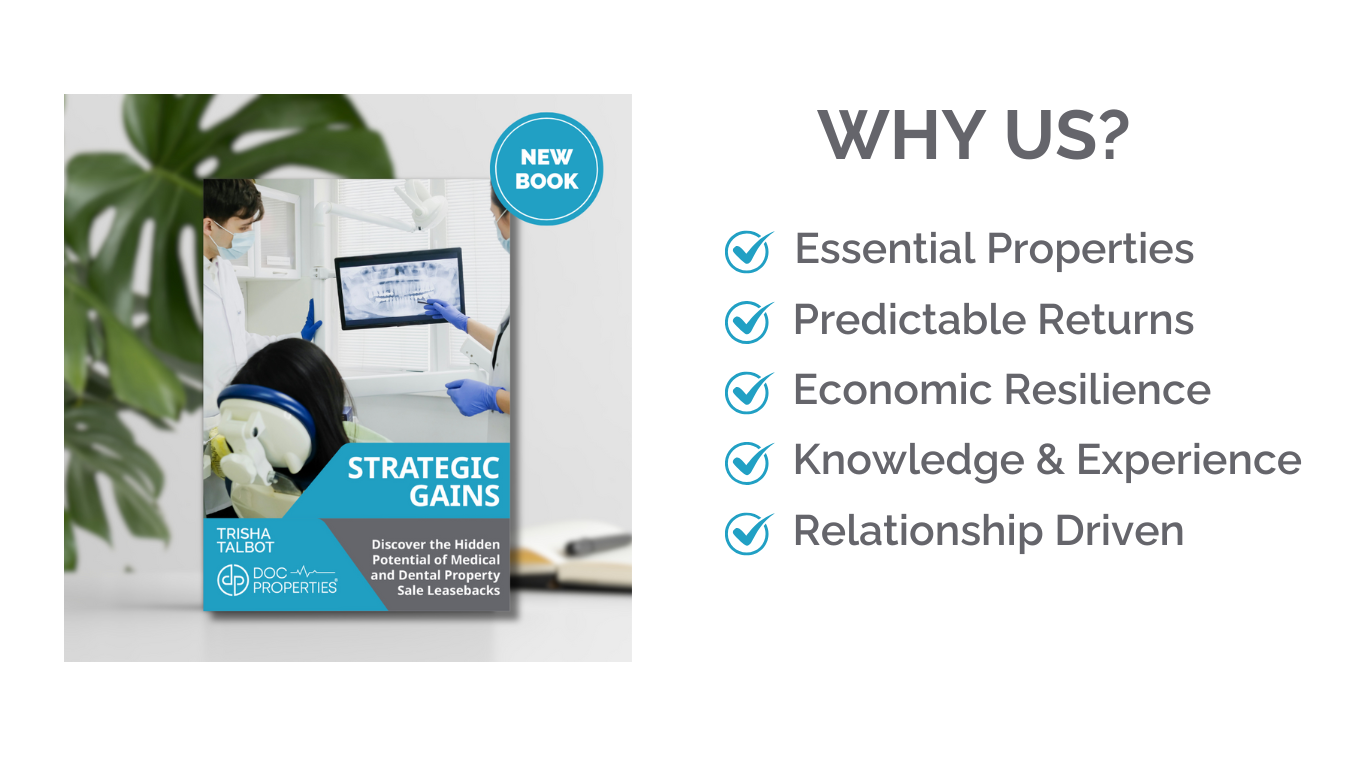

ABOUT THE BOOK
Investing in healthcare properties as an alternative asset class is an excellent way of diversifying your portfolio. Outpatient medical office buildings offer stability and predictability due to the long-term leases, high retention rates (of clinician tenants), low tenant default rates, annual increases, and triple net operating expenses.
Outpatient medical properties and dental clinics now deliver 50% of healthcare services, according to RevistaMed. Hence, a sale-leaseback transaction in an outpatient medical or dental building is an investment vehicle that offers cash flow and capital preservation. While all real estate is an inflation hedge and can create prosperity, healthcare properties are more than just recession-resilient. They are essential to public health, and are pandemic-, Amazon-, and technology-proof.
Outpatient medical properties and dental clinics now deliver 50% of healthcare services, according to RevistaMed. Hence, a sale-leaseback transaction in an outpatient medical or dental building is an investment vehicle that offers cash flow and capital preservation. While all real estate is an inflation hedge and can create prosperity, healthcare properties are more than just recession-resilient. They are essential to public health, and are pandemic-, Amazon-, and technology-proof.
THE BASICS
In an outpatient medical or dental property, a sale-leaseback typically occurs when the clinician agrees to a long-term lease and sells the property as income-producing to an investor seeking a continual cash flow stream. Prices are adjusted for the risks associated with property age, location, tenant financial strength, and lease term.
Clinicians can innovatively sell their property at its highest value to access capital tied up in real estate while maintaining operational control over the property where they practice. At the end of this sale-leaseback scenario, the practice becomes the tenant and the buyer becomes the landlord. This strategic financial maneuver has gained popularity across practice types as healthcare companies seek ways to optimize their capital structure and improve liquidity.
Clinicians can innovatively sell their property at its highest value to access capital tied up in real estate while maintaining operational control over the property where they practice. At the end of this sale-leaseback scenario, the practice becomes the tenant and the buyer becomes the landlord. This strategic financial maneuver has gained popularity across practice types as healthcare companies seek ways to optimize their capital structure and improve liquidity.
THE MECHANICS
Healthcare property sale-leasebacks involve the clinician tenant or healthcare company selling the property to an investor. The clinician or practice agrees to a long-term lease and a fair market lease rate, with annual increases and typically triple net (NNN) lease rates.
The current market cap rate determines the price based on the tenant’s financial strength, personal or corporate guarantees, and the condition and location of the property. An investor looking for immediate cash flow will buy the property for its income stream. Many investors of sale-leasebacks are looking for low-maintenance properties with strong tenants where they decide it is worth the risk to invest the capital to receive monthly income and the likelihood that they will sell it for a higher price in the future.
The current market cap rate determines the price based on the tenant’s financial strength, personal or corporate guarantees, and the condition and location of the property. An investor looking for immediate cash flow will buy the property for its income stream. Many investors of sale-leasebacks are looking for low-maintenance properties with strong tenants where they decide it is worth the risk to invest the capital to receive monthly income and the likelihood that they will sell it for a higher price in the future.
THE BENEFITS
Clinicians and healthcare companies that own their real estate can develop them at a lower cost of capital than most developers. However, continuing to own and operate these facilities requires hiring and managing property managers, contractors, and the property’s financial operations.
While some choose this route, sometimes the healthcare side of their business requires their focus and capital. A sale-leaseback allows them to operate on their property but releases the capital for expanding their core competency.
For the buyers, a sale-leaseback provides a property with a high-quality tenant in place, where, at most, they are responsible for maintaining the exterior. They can get an immediate income rather than lease the property or manage tenant improvement construction projects.
While some choose this route, sometimes the healthcare side of their business requires their focus and capital. A sale-leaseback allows them to operate on their property but releases the capital for expanding their core competency.
For the buyers, a sale-leaseback provides a property with a high-quality tenant in place, where, at most, they are responsible for maintaining the exterior. They can get an immediate income rather than lease the property or manage tenant improvement construction projects.

Free download of our new book
Submit your information and a link to the free digital version of the book will be sent to you.

DISCLAIMER: This book is intended for educational and entertainment purposes and not to provide specific real estate investment advice.